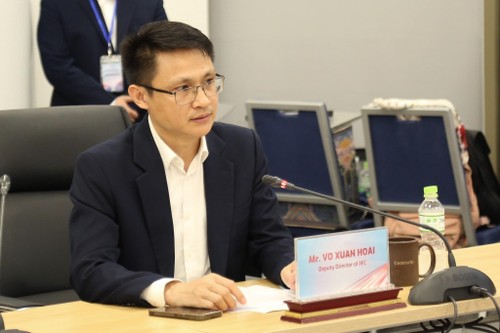
(Photo: Quoc Dung/VNA)
|
In the past 10 years, the global semiconductor industry grew 14% per year and earned 600 billion USD as of last year. The sector is expected to continue to grow strongly, reaching 1 trillion USD by 2030.
Vietnam, with strong political determination, a favorable investment and business environment, a skilled workforce, and comprehensive strategic partnerships with most countries with developed semiconductor industries, has great advantages to affirm its position in the global semiconductor industry.
Vo Xuan Hoai, Deputy Director of the National Innovation Center (NIC) of the Ministry of Planning and Investment, said that recently leaders of many large semiconductor corporations have come to Vietnam – the CEOs of Nvidia, Lam Research, and Global Foundary, and semiconductor equipment, packaging and testing manufacturers like Coherent, Amkor, and Intel.
“This proves that Vietnam has a very good semiconductor industry ecosystem. With the shift of the semiconductor industry supply chain, Vietnam has new opportunities to participate in this chain,” said Hoai.
 Vo Xuan Hoai, NIC Deputy Director (Photo: NIC) Vo Xuan Hoai, NIC Deputy Director (Photo: NIC) |
The Vietnamese Government has promulgated a strategy to develop Vietnam's semiconductor industry until 2030 with a vision to 2050. The strategy outlines a 3-phase roadmap with specific goals, including perfecting specific mechanisms and policies to ensure competitiveness with regional countries, synchronizing electricity, water, transportation, fiber optic cable, and information technology infrastructure, and developing high-quality human resources.
Nguyen Vinh Quang, Director of the FPT Semiconductor Joint Stock Company, said this is the right time for Vietnam to adopt a compatible strategy to help the Vietnamese semiconductor industry take off because other countries already have clear strategies to attract investment in semiconductor chips.
“This is the first time semiconductor companies have been mentioned, received strong support from the Government. There are many new points in the Government’s new strategy,” said Quang, adding, “As an insider, FPT is happy and sees this as a good opportunity for Vietnam and Vietnamese companies to develop and elevate Vietnam's position in the global semiconductor supply chain.”
Vietnam is completing its power transmission infrastructure from North to South and a clean water system, and repairing and upgrading airports and seaports to meet the industry’s growth.
In addition, support policies and tax and capital incentives for high-tech enterprises have been adopted. A focus has been put on developing human resources with a goal of having 50,000 semiconductor engineers by 2030.
International partners have praised the Vietnamese Government’s determination and committed to helping Vietnam achieve its goal of becoming a link in the global semiconductor supply chain.
Linda Tan, President of the Semiconductor Industry Association Southeast Asia, said that Vietnam’s semiconductor market is projected to reach an impressive 31.39 billion USD by 2029 with a compound annual growth rate of 11.48% from 2024 to 2029.
“We’re dedicated to nurturing the next generation of skilled professionals through comprehensive programs that range from rising STEM awareness to upskilling and reskilling the workforce,” said Tan, adding, “To help Vietnam build a workforce, a ready talent pool for its rapid economic growth, SEMI will continue to support Vietnam's ambitions in expanding its footprint in the semiconductor landscape through our global programs.”
40 years ago, Vietnam made a key institutional breakthrough with its renewal process, which opened up its economy and helped Vietnam escape poverty thanks to rice exports.
Now Vietnam has a great opportunity to make the most of the digital economy to develop its national economy and integrate into the global economy. Political determination and a long-term, strategic vision will be the basis for mobilizing Vietnam’s resources toward the goal of becoming a part of the global semiconductor supply chain.